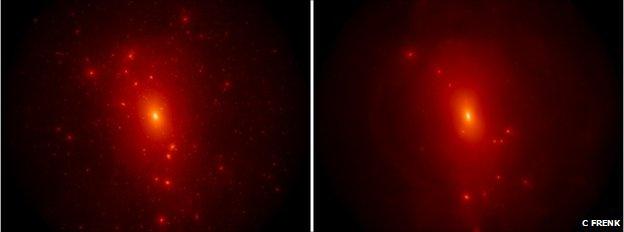Dwarf galaxies suggest dark matter theory may be wrong
- Published

Dwarf galaxies around the Milky Way are less dense than they should be if they held cold dark matter
Scientists' predictions about the mysterious dark matter purported to make up most of the mass of the Universe may have to be revised.
Research on dwarf galaxies suggests they cannot form in the way they do if dark matter exists in the form that the most common model requires it to.
That may mean that the Large Hadron Collider will not be able to spot it.
Leading cosmologist Carlos Frenk spoke of the "disturbing" developments at the British Science Festival in Bradford, external.
The current theory holds that around 4% of the Universe is made up of normal matter - the stuff of stars, planets and people - and around 21% of it is dark matter.
The remainder is made up of what is known as dark energy, an even less understood hypothetical component of the Universe that would explain its ever-increasing expansion.
Scientists' best ideas for the formation and structure of the Universe form what is called the "cosmological standard model", or lambda-CDM - which predicts elementary particles in the form of cold dark matter (CDM).

The Boulby mine is one of the facilities dedicated to the hunt for direct evidence of dark matter
These CDM particles are believed to have formed very early in the Universe's history, around one millionth of a second after the Big Bang, and they are "cold" in the sense that they are not hypothesised to be particularly fast-moving.
The existence of the particles has not yet been proven, as they are extremely difficult to detect - they cannot be "seen" in the traditional sense, and if they exist, they interact only very rarely with the matter we know.
Various experiments are being carried out in deep mines in Yorkshire, on the Fermi Space Telescope, and in the Large Hadron Collider (LHC) in Switzerland to try and detect these elusive particles, or indirect evidence of their effects.
So far, none of these experiments has conclusively spotted them.
Scientists working on the problem have recently expressed dismay at the universally negative results coming from the LHC, and this has led some to consider that the standard model may be wrong.
'Disturbing possibilities'
Prof Carlos Frenk at Durham University, working with the Virgo Consortium, external, now has data suggesting that our understanding of the formation and composition of the Universe is incomplete.
These data come from an unlikely source: dwarf galaxies, a "halo" of which surrounds our own Milky Way.
These dwarf galaxies are believed to be mostly made up of dark matter, and contain just a few stars. Their dimness has made them difficult to study in the past.
But the Virgo Consortium has created computer simulations to visualise how the dwarf galaxies formed, using their assumptions about CDM.
The team found that the final results of these simulations did not at all match what we observe. The models showed many more small galaxies in a wide halo around the Milky Way, whereas in reality there are fewer, larger dwarf galaxies.
Prof Frenk explained that there were two "equally disturbing possibilities" for why this is the case.
One idea is that many dwarf galaxies formed as in the simulation, but there were violent supernova explosions during their formation that radically changed the structure of the dwarf galaxy halo.
"If this were the case, it would mean that galaxy formation is a much more exciting process than we thought," said Prof Frenk.
But there are still uncertainties over whether the small fraction of normal matter in the Universe (4%) could have such a fundamental effect on the structure of the dark matter.
An alternative cause for the discrepancies between the modelled data and what we observe is much more fundamental: that CDM does not exist, and the predictions of the standard model relating to it are false.
Prof Frenk said that after working for 35 years with the predictions of the standard model, he is "losing sleep" over the results of the simulations.
Warmer Universe
But he believes he has found a solution to the CDM problem. He proposes that instead of "cold" dark matter that formed within the first one millionth of a second after the Big Bang, the Universe may instead be filled with warm dark matter (WDM).
The WDM would have formed later, up to minutes after the Big Bang, and is described as "warm" as the particles would be lighter and more energetic.
When simulations of galaxy formation are run with the later-forming WDM instead of CDM, the halo of dwarf galaxies has the same structure as we observe in reality.

Violent supernovae in early dwarf galaxy formation could be at the heart of the discrepancy
The WDM solution is "remarkably elegant", Prof Frenk said, and it means that "the standard model is by no means dead".
But if all dark matter is WDM and not CDM, this poses major problems for our current attempts to detect it.
The LHC is designed to recreate the conditions one millionth of a second after the Big Bang. If WDM is the dominant dark matter, however, the facility will not see a trace of the particles.
Other possibilities exist for trying to detect WDM. The most likely WDM particle, the "sterile neutrino", could be identified by the X-rays it emits; but much more sensitive X-ray detectors would be needed.
Alternatively, the James Webb Space Telescope, which is designed to peer into space to look for the earliest stars, and is due to be launched in 2018 pending funding agreements, could be used to prove the non-existence of CDM.
If WDM is the dark matter holding galaxies together, then at the very earliest stages of the Universe, the telescope will see nothing, because the WDM and its accompanying galaxies would not have yet formed.
Prof Frenk explained that there is no definitive proof yet that the dark matter theories need a "paradigm shift", but he remains positive that an answer will be found soon.
"Dark matter is poised for big developments in the next few months," he said.
- Published7 September 2011
- Published25 July 2011
- Published29 June 2011
- Published25 February 2011